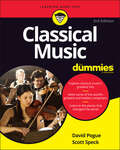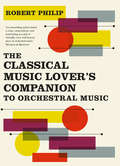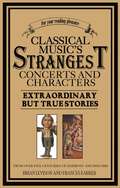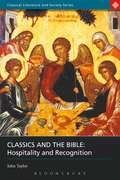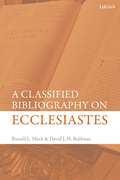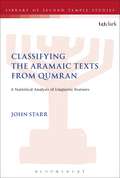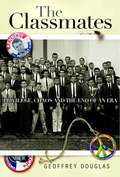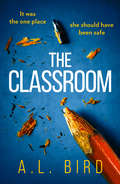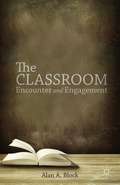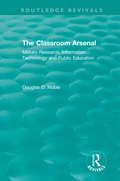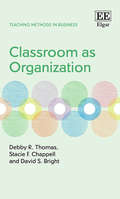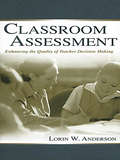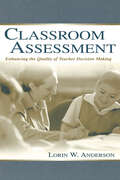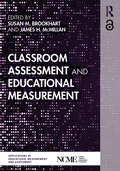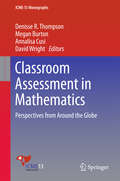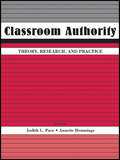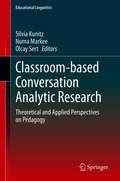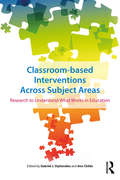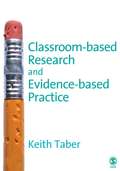- Table View
- List View
Classical Music For Dummies
by David Pogue Scott SpeckClassical music was never meant to be an art for snobs! In the 1700s and 1800s, classical music was popular music. People went to concerts with their friends, they brought snacks and drinks, and cheered right in the middle of the concert. Well, guess what? Three hundred years later, that music is just as catchy, thrilling, and emotional. From Bach to Mozart and Chopin, history's greatest composers have stood the test of time and continue to delight listeners from all walks of life. And in Classical Music For Dummies, you'll dive deeply into some of the greatest pieces of music ever written. You'll also get: A second-by-second listening guide to some of history's greatest pieces, annotated with time codes A classical music timeline, a field guide to the orchestra, and listening suggestions for your next foray into the classical genre Expanded references so you can continue your studies with recommended resources Bonus online material, like videos and audio tracks, to help you better understand concepts from the book Classical Music For Dummies is perfect for anyone who loves music. It's also a funny, authoritative guide to expanding your musical horizons—and to learning how the world's greatest composers laid the groundwork for every piece of music written since.
The Classical Music Lover's Companion to Orchestral Music
by Robert PhilipAn invaluable guide for lovers of classical music designed to enhance their enjoyment of the core orchestral repertoire from 1700 to 1950 Robert Philip, scholar, broadcaster, and musician, has compiled an essential handbook for lovers of classical music, designed to enhance their listening experience to the full. Covering four hundred works by sixty-eight composers from Corelli to Shostakovich, this engaging companion explores and unpacks the most frequently performed works, including symphonies, concertos, overtures, suites, and ballet scores. It offers intriguing details about each piece while avoiding technical terminology that might frustrate the non-specialist reader. Philip identifies key features in each work, as well as subtleties and surprises that await the attentive listener, and he includes enough background and biographical information to illuminate the composer’s intentions. Organized alphabetically from Bach to Webern, this compendium will be indispensable for classical music enthusiasts, whether in the concert hall or enjoying recordings at home.
Classical Music's Strangest Concerts and Characters
by Brian LevisonExtracted from five hundred years of musical history, this is a fascinating collection of stories about classical music's most unusual concerts and characters.
Classics and the Bible: Hospitality and Recognition (Classical Literature and Society)
by John Taylor"Classics and the Bible" looks at story-patterns and themes which Greek and Latin literature shares with the Hebrew scriptures and the New Testament. Direct influence or a common source can explain some similarities, but uncannily parallel plots and forms of expression seem more often to occur independently. Classical and biblical texts constantly illuminate each other. Hospitality and recognition are central themes in both traditions, and also metaphors about the relation between them. Classical and biblical authors alike tell stories which need to be read in the light of other stories. The relation between the present and the heroic past is crucial to both traditions, and both raise fundamental questions about the relation of text and reader. The first three chapters consider the subject from the classical side: Homer, the Greek tragedians and Plato, and Virgil; the fourth turns to the New Testament; and the fifth to aspects of later reception. Readers should ideally be equipped with a Bible, English translations of a few major classical authors, and an open mind.
Classics and the Bible: Hospitality and Recognition (Classical Literature and Society)
by John Taylor"Classics and the Bible" looks at story-patterns and themes which Greek and Latin literature shares with the Hebrew scriptures and the New Testament. Direct influence or a common source can explain some similarities, but uncannily parallel plots and forms of expression seem more often to occur independently. Classical and biblical texts constantly illuminate each other. Hospitality and recognition are central themes in both traditions, and also metaphors about the relation between them. Classical and biblical authors alike tell stories which need to be read in the light of other stories. The relation between the present and the heroic past is crucial to both traditions, and both raise fundamental questions about the relation of text and reader. The first three chapters consider the subject from the classical side: Homer, the Greek tragedians and Plato, and Virgil; the fourth turns to the New Testament; and the fifth to aspects of later reception. Readers should ideally be equipped with a Bible, English translations of a few major classical authors, and an open mind.
Classified Bibliography on Ecclesiastes
by David J. Beldman Russell L. MeekThis volume is a comprehensive listing of bibliographical references to writings on the book of Ecclesiastes, beginning from 1900. Rather than being presented in alphabetical order, these references are classified according to genre, chapter, subject and theme; among the myriad of classifications are biblical theology, commentaries, death and the afterlife, God/the divine, joy, language, sexuality, structure and wisdom.These classifications have been selected by specialists of Ecclesiastes, in order to guide scholars and researchers through the wealth of secondary material available and to prompt further research on the text. Through its collation of the incredible amount of bibliographical data on the book of Ecclesiastes, this collection will prove a vital resource for those working on Ecclesiastes for years to come.
Classified Bibliography on Ecclesiastes
by David J. Beldman Russell L. MeekThis volume is a comprehensive listing of bibliographical references to writings on the book of Ecclesiastes, beginning from 1900. Rather than being presented in alphabetical order, these references are classified according to genre, chapter, subject and theme; among the myriad of classifications are biblical theology, commentaries, death and the afterlife, God/the divine, joy, language, sexuality, structure and wisdom.These classifications have been selected by specialists of Ecclesiastes, in order to guide scholars and researchers through the wealth of secondary material available and to prompt further research on the text. Through its collation of the incredible amount of bibliographical data on the book of Ecclesiastes, this collection will prove a vital resource for those working on Ecclesiastes for years to come.
Classifying the Aramaic Texts from Qumran: A Statistical Analysis of Linguistic Features (The Library of Second Temple Studies)
by John StarrAnalysis of the scroll fragments of the Qumran Aramaic scrolls has been plentiful to date. Their shared characteristics of being written in Aramaic, the common language of the region, not focused on the Qumran Community, and dating from the 3rd century BCE to the 1st century CE have enabled the creation of a shared identity, distinguishing them from other fragments found in the same place at the same time. This classification, however, could yet be too simplistic as here, for the first time, John Starr applies sophisticated statistical analyses to newly available electronic versions of these fragments. In so doing, Starr presents a potential new classification which comprises six different text types which bear distinctive textual features, and thus is able to narrow down the classification both temporally and geographically.Starr's re-visited classification presents fresh insights into the Aramaic texts at Qumran, with important implications for our understanding of the many strands that made up Judaism in the period leading to the writing of the New Testament.
The Classmates: Privilege, Chaos, and the End of an Era
by Geoffrey DouglasFifty years ago, in the fall of 1957, two thirteen-year-old boys were enrolled at an elite, boys-only New England boarding school. One of them, descended from wealth and eminence, would go on to Yale, then to a career as a navy officer and Vietnam war hero, and finally to the U.S. Senate, from where he would fall just short of the White House. The other was a scholarship student, a misfit giant of a boy from a Pennsylvania farm town who would suffer shameful debasements at the hands of his classmates, then go on to a solitary and largely anonymous life as a salesman of encyclopedias and trailer parts--before dying, alone, twelve months after his classmate's narrow loss on Election Day 2004. It is around these two figures, John Kerry and a boy known here only as Arthur, the bookends of a class of one hundred boys, that Geoffrey Douglas--himself a member of that boarding-school class--builds this remarkable memoir. His portrait of their lives and the lives of five others in that class--two more Vietnam veterans with vastly divergent stories, a federal judge, a gay New York artist who struggled for years to find his place in the world, and Douglas himself--offers a memorable look back to a generation caught between the expectations of their fathers and the sometimes terrifying pulls of a society driven by war, defiance, and self-doubt. The class of 1962 was not so different from any other, with its share of swaggerers and shining stars, outcasts and scholarship students. Its distinction was in its timing: at the precise threshold of the cultural and political upheavals of the late 1960s. The world these boys had been trained to enter and to lead, a world very similar to their fathers', would be exploded and recast almost at the moment of their entrance--forcing choices whose consequences were sometimes lifelong. Douglas's chronicle of those times and choices is both a capsule history of an era and a literary tour de force.
The Classroom: A Gripping And Terrifying Thriller Which Asks Who You Can Trust In 2018 (Harlequin Audio Ser.)
by A. L. BirdDon’t miss the chilling new psychological thriller from A.L. Bird, author of The Good Mother and Don’t Say a Word, perfect for fans of C L Taylor, Sherryl Brown and Lisa Hall.
The Classroom: Encounter and Engagement (Studies In Curriculum Theory Ser.)
by A. BlockWhat goes on in a classroom? can mean "Are teachers imparting knowledge that will raise test scores?" or it can mean much more. In this series of essays, Block addresses the nature of the classroom as a place for encounter and engagements: with curriculum materials and books, between teachers and students, and with the self.
The Classroom Arsenal: Military Research, Information Technology and Public Education (Routledge Revivals)
by Douglas D. NobleA quarter of a century after its initial publication, The Classroom Arsenal remains pivotal in understanding and challenging the relentless promotion of technology to reform education. This seemingly benign education technology juggernaut carries forward the momentum of military agendas in man-machine systems detailed in the book. Promoters continue to flood schools with technology and its (still unfulfilled) promise of cutting edge, "personalized learning." Meanwhile, they continue as well their insatiable pursuit of federal funding, educational legitimacy, corporate profits, and access to student subjects and their accumulated learning data for product development. Less understood, though, is a companion enterprise, there from the start, to replace teaching and learning in traditional classrooms by efficient automated systems that manage and monitor human cognition and learning for high-performance systems, from weapons systems to high tech corporations. As education is moved imperceptibly away from its traditional humanistic aims and from the classroom itself, the goal of this human engineering project, the depersonalized accumulation of cognitive components for a 21st century militarized economy, best befits the book’s original title: "The Human Arsenal." This ongoing military/corporate-sponsored enterprise continues to impact education today, largely unnoticed. One example is the federally-funded Advanced Distributed Learning Initiative (ADL), which has been a major force behind the implementation of electronic learning systems, now used in all Defense Department and federal employee training. With the Defense Advanced Research Project Agency (ARPA) ADL is developing structures to capture students’ soft skills, and the Army Research Laboratory is developing "intelligent tutoring systems" to enable "instructional management of affect, engagement, and grit (perseverance)." ADL through the Department of Defense has developed Experience API, a learning technology that can monitor all student online and offline interactions and archive these in date lockers or learning record stores. ADL has already impacted thousands of school districts through nonprofits such as IMS Global and Future Ready Schools, part of an industry massively subsidized by high tech corporations and valued at $255 billion annually. A $90 million Advanced Research Projects Agency for Education (ARPA-ED), modeled after the military’s ARPA, has been proposed to fund "dramatic breakthroughs in learning and teaching." These include "digital tutors as effective as personal tutors" and, with the Navy’s Full Spectrum Learning project, "data collection tools for personalized education modeled after corporate data analysis that identifies consumer patterns and preferences." ADL is just one example of how the military/corporate ed tech enterprise is changing public education by hollowing it out into something that can be digitized, data-driven, automated, and monitored. Its promoters envision education as children interacting with online learning systems where, based on past performance, algorithms will serve up what each student needs to know next. Through this digital curriculum, students create virtual educational identities at very young ages and learning devices are watching students as much as students are watching them. Such is the education landscape presaged by The Classroom Arsenal a quarter century ago, whose origins and trajectories need to be deeply understood now more than ever.
The Classroom Arsenal: Military Research, Information Technology and Public Education (Routledge Revivals)
by Douglas D. NobleA quarter of a century after its initial publication, The Classroom Arsenal remains pivotal in understanding and challenging the relentless promotion of technology to reform education. This seemingly benign education technology juggernaut carries forward the momentum of military agendas in man-machine systems detailed in the book. Promoters continue to flood schools with technology and its (still unfulfilled) promise of cutting edge, "personalized learning." Meanwhile, they continue as well their insatiable pursuit of federal funding, educational legitimacy, corporate profits, and access to student subjects and their accumulated learning data for product development. Less understood, though, is a companion enterprise, there from the start, to replace teaching and learning in traditional classrooms by efficient automated systems that manage and monitor human cognition and learning for high-performance systems, from weapons systems to high tech corporations. As education is moved imperceptibly away from its traditional humanistic aims and from the classroom itself, the goal of this human engineering project, the depersonalized accumulation of cognitive components for a 21st century militarized economy, best befits the book’s original title: "The Human Arsenal." This ongoing military/corporate-sponsored enterprise continues to impact education today, largely unnoticed. One example is the federally-funded Advanced Distributed Learning Initiative (ADL), which has been a major force behind the implementation of electronic learning systems, now used in all Defense Department and federal employee training. With the Defense Advanced Research Project Agency (ARPA) ADL is developing structures to capture students’ soft skills, and the Army Research Laboratory is developing "intelligent tutoring systems" to enable "instructional management of affect, engagement, and grit (perseverance)." ADL through the Department of Defense has developed Experience API, a learning technology that can monitor all student online and offline interactions and archive these in date lockers or learning record stores. ADL has already impacted thousands of school districts through nonprofits such as IMS Global and Future Ready Schools, part of an industry massively subsidized by high tech corporations and valued at $255 billion annually. A $90 million Advanced Research Projects Agency for Education (ARPA-ED), modeled after the military’s ARPA, has been proposed to fund "dramatic breakthroughs in learning and teaching." These include "digital tutors as effective as personal tutors" and, with the Navy’s Full Spectrum Learning project, "data collection tools for personalized education modeled after corporate data analysis that identifies consumer patterns and preferences." ADL is just one example of how the military/corporate ed tech enterprise is changing public education by hollowing it out into something that can be digitized, data-driven, automated, and monitored. Its promoters envision education as children interacting with online learning systems where, based on past performance, algorithms will serve up what each student needs to know next. Through this digital curriculum, students create virtual educational identities at very young ages and learning devices are watching students as much as students are watching them. Such is the education landscape presaged by The Classroom Arsenal a quarter century ago, whose origins and trajectories need to be deeply understood now more than ever.
Classroom as Organization (Teaching Methods in Business series)
by Debby R. Thomas Stacie F. ChappellClassroom as Organization (CAO) is a powerful teaching methodology, particularly well-suited for teaching business topics, that can enliven students’ learning experience while giving them the opportunity to practice and develop workplace-related skills. This book provides a comprehensive background to the CAO teaching methodology, including its origins, evolution, and various applications. From this basis, the considerations of how to teach and design a CAO are explored. The book distills lessons learned from the literature and the authors’ practice into a comprehensive design that can be easily implemented by educators new to this methodology. Detailed templates from the authors’ own practice enable educators to turn their classroom into an organization, empower the students to run that organization, and watch the learning experience come alive. If you are not familiar with CAO, this book provides a comprehensive resource. If you are familiar with CAO, but have been afraid to try it, this book provides the support to take the next step in your practice of experiential teaching and learning. This book was written for experiential educators as well as business or organizational behavior and management professors looking for a creative way to engage students while creating a deep and meaningful learning experience.
Classroom Assessment: Enhancing the Quality of Teacher Decision Making
by Lorin W. AndersonThis book is based on the belief that decision making is perhaps the most critical of all teaching skills and that good assessments lie at the core of good decision making. To become better teachers then, teachers must learn to make informed decisions about both individual students (learning decisions) and about groups of students (teaching decisions). This book gives equal status to both types of decisions and shows how assessment is integral to both. The organization of the book is sequential, mirroring the way in which information should be used to make decisions. It begins with a conceptual framework linking information to decision making, then moves to the design of assessment instruments and the collection of assessment information, then to the interpretation of assessment information and, finally, to reporting the results of both the assessment and the decision-making process. There is an emphasis throughout on linking why teachers assess with what and how they assess. Other key features include: * Practical Framework -- The book's framework corresponds to the framework that teachers use to grade their students: conduct (classroom behavior), effort (student motivation), and achievement (student learning). * Unique Chapters -- There are separate chapters on interpreting assessment information prior to decision making and on reporting assessment information to parents, teachers, and administrators. * Flexibility -- Because of its modest length and price, and its practical focus on the links between assessment and everyday teacher decision making, this text can be used either in full-length assessment courses for teachers or to teach the assessment units in educational psychology or integrated methods courses.
Classroom Assessment: Enhancing the Quality of Teacher Decision Making
by Lorin W. AndersonThis book is based on the belief that decision making is perhaps the most critical of all teaching skills and that good assessments lie at the core of good decision making. To become better teachers then, teachers must learn to make informed decisions about both individual students (learning decisions) and about groups of students (teaching decisions). This book gives equal status to both types of decisions and shows how assessment is integral to both. The organization of the book is sequential, mirroring the way in which information should be used to make decisions. It begins with a conceptual framework linking information to decision making, then moves to the design of assessment instruments and the collection of assessment information, then to the interpretation of assessment information and, finally, to reporting the results of both the assessment and the decision-making process. There is an emphasis throughout on linking why teachers assess with what and how they assess. Other key features include: * Practical Framework -- The book's framework corresponds to the framework that teachers use to grade their students: conduct (classroom behavior), effort (student motivation), and achievement (student learning). * Unique Chapters -- There are separate chapters on interpreting assessment information prior to decision making and on reporting assessment information to parents, teachers, and administrators. * Flexibility -- Because of its modest length and price, and its practical focus on the links between assessment and everyday teacher decision making, this text can be used either in full-length assessment courses for teachers or to teach the assessment units in educational psychology or integrated methods courses.
Classroom Assessment and Educational Measurement
by Susan M. Brookhart James H. McMillanClassroom Assessment and Educational Measurement explores the ways in which the theory and practice of both educational measurement and the assessment of student learning in classroom settings mutually inform one another. Chapters by assessment and measurement experts consider the nature of classroom assessment information, from student achievement to affective and socio-emotional attributes; how teachers interpret and work with assessment results; and emerging issues in assessment such as digital technologies and diversity/inclusion. This book uniquely considers the limitations of applying large-scale educational measurement theory to classroom assessment and the adaptations necessary to make this transfer useful. Researchers, graduate students, industry professionals, and policymakers will come away with an essential understanding of how the classroom assessment context is essential to broadening contemporary educational measurement perspectives.
Classroom Assessment and Educational Measurement
by Susan M. Brookhart James H. McMillanClassroom Assessment and Educational Measurement explores the ways in which the theory and practice of both educational measurement and the assessment of student learning in classroom settings mutually inform one another. Chapters by assessment and measurement experts consider the nature of classroom assessment information, from student achievement to affective and socio-emotional attributes; how teachers interpret and work with assessment results; and emerging issues in assessment such as digital technologies and diversity/inclusion. This book uniquely considers the limitations of applying large-scale educational measurement theory to classroom assessment and the adaptations necessary to make this transfer useful. Researchers, graduate students, industry professionals, and policymakers will come away with an essential understanding of how the classroom assessment context is essential to broadening contemporary educational measurement perspectives.
Classroom Assessment in Mathematics: Perspectives from Around the Globe (ICME-13 Monographs)
by Denisse R. Thompson Megan Burton Annalisa Cusi David WrightThis book consists of 13 papers developed by participants in the ICME 13 Topic Study Group 40 on Classroom Assessment. The individual papers discuss various aspects of classroom assessment, focusing particularly on formative assessment as assessment for learning, and are grouped into four main sections: Examples of Classroom Assessment in Action, Technology as a Tool for Classroom Assessment, Statistical Models for Formative Assessment, and Engaging Teachers in Formative Assessment. The book opens with a brief discussion of the use of formative assessment as a critical component of the teaching–learning process and concludes with an overview of lessons learned and ideas for future research. It is of interest to classroom teachers, university teacher educators, professional development providers and school supervisors.
Classroom Authority: Theory, Research, and Practice
by Judith L. Pace Annette HemmingsThis book describes and analyzes authority relationships in classrooms through explorations of theory, prior research, and contemporary qualitative studies. The emphasis is on the social construction of authority and the crucial role authority plays in K-16 teachers' pedagogy and students' academic engagement and achievement.The introductory chapter grounds the reader in social theory on authority; presents groundbreaking qualitative studies of classroom authority; describes ideological debates over authority in schools; and discusses implications for research, practice, and policy. Six field-based qualitative studies illuminate the dynamics of authority across a spectrum of K-12 and college settings. These studies feature a variety of methodologies, theoretical lenses, and interpretive perspectives that the authors use to gather and analyze data. The emphasis in all the chapters is on the nature, negotiation, and implications of authority relations between teachers and students. The epilogue pulls the book together by elucidating new findings and vital themes that expand the reader's vision of what classroom authority means, how it is constructed, and why it is so important.This book seeks to revitalize dialogue and research on classroom authority with attention to the contextual factors that bear on its social construction. It is aimed at teacher educators, scholars, policymakers, students of education, and practitioners who seek empirically based understanding of authority that is inextricably connected to classroom life and ultimately to the larger issues of educational quality and democracy in schools and society.
Classroom Authority: Theory, Research, and Practice
by Judith L. Pace Annette HemmingsThis book describes and analyzes authority relationships in classrooms through explorations of theory, prior research, and contemporary qualitative studies. The emphasis is on the social construction of authority and the crucial role authority plays in K-16 teachers' pedagogy and students' academic engagement and achievement.The introductory chapter grounds the reader in social theory on authority; presents groundbreaking qualitative studies of classroom authority; describes ideological debates over authority in schools; and discusses implications for research, practice, and policy. Six field-based qualitative studies illuminate the dynamics of authority across a spectrum of K-12 and college settings. These studies feature a variety of methodologies, theoretical lenses, and interpretive perspectives that the authors use to gather and analyze data. The emphasis in all the chapters is on the nature, negotiation, and implications of authority relations between teachers and students. The epilogue pulls the book together by elucidating new findings and vital themes that expand the reader's vision of what classroom authority means, how it is constructed, and why it is so important.This book seeks to revitalize dialogue and research on classroom authority with attention to the contextual factors that bear on its social construction. It is aimed at teacher educators, scholars, policymakers, students of education, and practitioners who seek empirically based understanding of authority that is inextricably connected to classroom life and ultimately to the larger issues of educational quality and democracy in schools and society.
Classroom-based Conversation Analytic Research: Theoretical and Applied Perspectives on Pedagogy (Educational Linguistics #46)
by Olcay Sert Silvia Kunitz Numa MarkeeThis book presents an international range of conversation analytic (CA) studies of classroom interaction which all discuss their empirical findings in terms of their theoretical and methodological contribution to the field of second language studies and their potential pedagogical relevance. The volume is thus unique in its focus on the theoretical and practical insights of CA classroom-based research and on the impact that such insights might have at the pedagogical level, from teaching to testing to teacher education. Given the growing interest in the pedagogical applicability of CA research, this book is a timely addition to the existing literature.
Classroom-based Interventions Across Subject Areas: Research to Understand What Works in Education
by Gabriel J. Stylianides Ann ChildsClassroom-based Interventions Across Subject Areas explores cutting-edge educational research that has real potential to support the improvement of classroom practice. Written by expert researchers and practitioners, it provides empirically tested and theory-based approaches that practitioners can use to improve learning in classroom settings. This edited volume provides examples of classroom-based interventions in English, mathematics, science, languages, history, and geography. Taking as its basis research which has been conducted in actual classrooms with close collaboration between researchers and practitioners, this text will help researchers and practitioners understand how and why interventions can be successful or not. The text further considers the broad theoretical and practical issues that derive from intervention studies, including the nature of collaboration between researchers and teachers and ways of adapting effective classroom-based interventions for use in different contexts. Offering insight into the methodology behind successful classroom-based interventions, this text will be essential reading for students of education, trainee teachers, and all those concerned with how educational research can impact on teaching and learning.
Classroom-based Interventions Across Subject Areas: Research to Understand What Works in Education
by Gabriel J. Stylianides Ann ChildsClassroom-based Interventions Across Subject Areas explores cutting-edge educational research that has real potential to support the improvement of classroom practice. Written by expert researchers and practitioners, it provides empirically tested and theory-based approaches that practitioners can use to improve learning in classroom settings. This edited volume provides examples of classroom-based interventions in English, mathematics, science, languages, history, and geography. Taking as its basis research which has been conducted in actual classrooms with close collaboration between researchers and practitioners, this text will help researchers and practitioners understand how and why interventions can be successful or not. The text further considers the broad theoretical and practical issues that derive from intervention studies, including the nature of collaboration between researchers and teachers and ways of adapting effective classroom-based interventions for use in different contexts. Offering insight into the methodology behind successful classroom-based interventions, this text will be essential reading for students of education, trainee teachers, and all those concerned with how educational research can impact on teaching and learning.
Classroom-based Research and Evidence-based Practice: A Guide for Teachers (PDF)
by Dr Keith Taber`This is an exceptionally strong book. I learnt much of value from it, yet the text is accessible to PGCE students. It is packed with interesting and valid arguments and shows a great understanding both of classrooms and of educational research' - Michael Reiss, Institute of Education, University of London Invaluable for anyone undertaking initial teacher training courses and other postgraduate courses involving an element of educational research, this text equips the reader with the necessary knowledge and skills to be confident in appreciating the nature, limitations and possibilities of small-scale classroom research, and critically reading the research of others. It includes case examples and pedagogical features throughout to enable the reader to fully engage with the issues surrounding teaching and learning.
